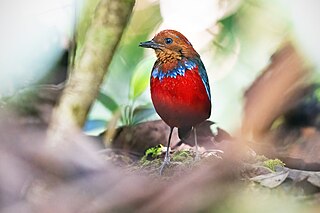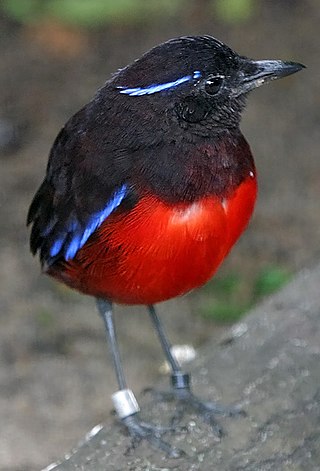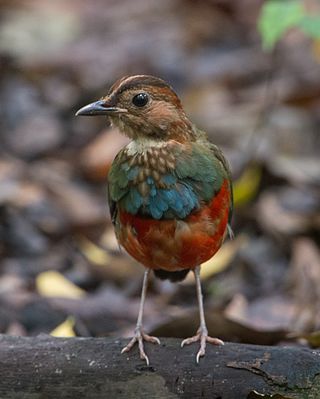
Pittas are a family, Pittidae, of passerine birds found in Asia, Australasia and Africa. There are 44 species of pittas, all similar in general appearance and habits. The pittas are Old World suboscines, and their closest relatives among other birds are in the genera Smithornis and Calyptomena. Initially placed in a single genus, as of 2009 they have been split into three genera: Pitta, Erythropitta and Hydrornis. Pittas are medium-sized by passerine standards, at 15 to 25 cm (5.9–9.8 in) in length, and stocky, with strong, longish legs and long feet. They have very short tails and stout, slightly decurved bills. Many have brightly coloured plumage.

The superb pitta is a large pitta that is endemic to Manus Island which lies to the north of Papua New Guinea.

The red-naped fruit dove is a species of bird in the family Columbidae. It is endemic to Sumba.

The blue-banded pitta is a species of bird in the family Pittidae. It is endemic to the island of Borneo, where it is found in all three countries that share the island: Malaysia, Brunei and Indonesia. Its natural habitat is subtropical or tropical moist lowland forest.

The Philippine pitta or blue-breasted pitta, is a species of bird in the family Pittidae. It has a pointed beak and has a red belly with a green blue band above. It is found in Indonesia and the Philippines. Its natural habitat is subtropical or tropical moist lowland forest. It was considered the nominate subspecies of the red-bellied pitta. This species has a wingspan of 20 - 25cm and is 17.5 - 20cm tall. In the class Aves it lays eggs and has feathers covering its entire body, it also has wings and can fly. As the illustration on your right shows it has short tail feathers and has a small brown head.

The garnet pitta is a species of bird in the family Pittidae. It is found in Brunei, Indonesia, Malaysia, Myanmar, Singapore, and Thailand. Its natural habitat is subtropical or tropical moist lowland forest. It is threatened by habitat loss. The form occurring in the Malaysian state of Sabah has been split as the black-crowned pitta.
The whiskered pitta is a rare species of bird in the family Pittidae. It is endemic to Luzon in the Philippines. This bird is the largest pitta in the country reaching 23 cm long and 116 g in mass. It has a brownish head, blue breast, and red belly. It has broad ash malar or "whiskers". Its natural habitat is tropical moist lowland forest and tropical moist montane forest. It is threatened by habitat loss and trapping. It is one of the most sought after birds by birdwatchers in the Philippines.

The graceful pitta, sometimes alternatively known as the black-crowned pitta, is a species of bird in the family Pittidae. It occurs in Sumatra in Indonesia, where its natural habitat is subtropical or tropical moist montane forests. It is threatened by habitat loss.

The black-crowned pitta, also known as the black-headed pitta, black-and-crimson pitta, black-and-scarlet pitta or black-crowned garnet pitta, is a brightly coloured, ground-dwelling, bird species in the pitta family. It is endemic to the Southeast Asian island of Borneo. It was described by John Gould in 1877, with the type locality recorded as the Lawas River in northern Sarawak.

The Sulawesi pitta is a species of pitta. It was considered a subspecies of the red-bellied pitta. It is endemic to Indonesia where it occurs in Sulawesi, Manterawu, and Togian Islands. Its natural habitat is subtropical or tropical moist lowland forest. It is threatened by habitat loss.

The Siau pitta or Siao pitta is a species of the pitta. It was considered a subspecies of the red-bellied pitta. It is endemic to Indonesia where it occurs in Siau and Tagulandang. Its natural habitat is subtropical or tropical moist lowland forests. It is threatened by habitat loss.

The Sangihe pitta is a species of the pitta. It was considered a subspecies of the red-bellied pitta. It is endemic to Indonesia where it occurs in the Sangihe Islands. Its natural habitat is subtropical or tropical moist lowland forests. It is threatened by habitat loss.
The South Moluccan pitta is a species of pitta. It was formerly considered a subspecies of the red-bellied pitta. It is endemic to Indonesia where it occurs on Buru and Seram. Its natural habitat is subtropical or tropical moist lowland forests. It is threatened by habitat loss.

The North Moluccan pitta is a species of the pitta. It was considered a subspecies of the red-bellied pitta. It is endemic to Indonesia where it occurs on the northern Moluccas. Its natural habitat is subtropical or tropical moist lowland forests. It is threatened by habitat loss.
The Louisiade pitta is a species of the pitta. It was considered a subspecies of the red-bellied pitta. It is endemic to Rossel Island in the Louisiade Archipelago in Papua New Guinea. Its natural habitat is subtropical or tropical moist lowland forests. It may be threatened by habitat loss, but is currently listed by the IUCN as Data Deficient as there have been no definite records since the type specimen was collected in 1898. However an expedition to the island in 2014 revealed that local people said they still encountered it.
The Bismarck pitta or New Ireland pitta is a species of pitta. It was formerly considered conspecific with the red-bellied pitta. It is endemic to the Bismarck Archipelago in Papua New Guinea. Its natural habitat is subtropical or tropical moist lowland forests. It is threatened by habitat loss.

The Papuan pitta is a species of pitta. It was formerly considered a subspecies of the red-bellied pitta. It is found in the Aru Islands, New Guinea and the northern Cape York Peninsula. Its natural habitat is subtropical or tropical moist lowland forest. It is threatened by habitat loss.

Red-bellied pitta has been split into the following species:
The Tabar pitta is a species of the pitta bird. It was considered a subspecies of the Bismarck pitta, and some taxonomic authorities still consider it so. It is endemic to the Tabar Group in Papua New Guinea. Its natural habitat is subtropical or tropical moist lowland forests. It is threatened by habitat loss.
The New Britain pitta is a species of the pitta. It was considered a subspecies of the Bismarck pitta, and some taxonomic authorities still consider it so. It is endemic to New Britain in Papua New Guinea. Its natural habitat is subtropical or tropical moist lowland forests. It is threatened by habitat loss.














